Wonderful wood
by John Robinson
Australian Shooter August 2002
Firearms have been many things to many people. To most, they are simply tools that are required to do a job. Their function takes priority over their form and the battered Brno sliding around in the back of a farmer’s 4WD is no different to a shovel or a chainsaw. At the other end of the scale, a firearm may not only need to deliver performance, but also do it in a package that satisfies the aesthetic requirements of the owner.
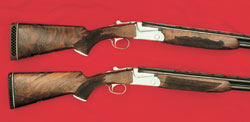 The main vehicle for enhancing the visual appeal of any long arm is the wood from which the stock is made and, throughout the modern era, the quality of a gun has almost always been judged by the quality of the timber used in its stock.
The main vehicle for enhancing the visual appeal of any long arm is the wood from which the stock is made and, throughout the modern era, the quality of a gun has almost always been judged by the quality of the timber used in its stock.
During the past 20 years, the utility end of the gun market has been taken over by synthetic polymer or laminated timber ‘woodwork’. These modern materials do a great job of providing stable and tough stocks for sporting rifles, although some manufacturers continue to offer natural wood stocks on their standard sporting rifles.
Almost without exception, higher-grade firearms offer selected walnut as their stock material option, carrying on the practice of using this marvellous timber for fine firearms - a tradition for two centuries.
While the world abounds with a great range of wood varieties, walnut has never been supplanted as the wood of choice for gunstocks. Walnut has four characteristics that make it desirable as a gunstock timber. Firstly, it is not too heavy. Few of us would like to carry a rifle with a jarrah or ironbark stock. Secondly, it has good mechanical strength. This is vital to withstand the mechanical recoil forces and the rigors of field use. Thirdly, it machines well and produces a fine finish, making it suitable for chequering and other precision cutting typical of a rifle stock. Finally, it is an attractive timber, with warm and contrasting colors that can be spectacular in wood cut from appropriate locations in the tree.
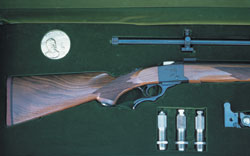 This is not to say that other timber species
will not do a good job. Exotic species like mesquite, birds-eye maple
and some tropical timbers such as coco-bolo can produce spectacular looking
gunstocks, as can some Australian species such as acacia melinoxylon.
However, availability and consistency has limited the commercial use of
these timbers.
This is not to say that other timber species
will not do a good job. Exotic species like mesquite, birds-eye maple
and some tropical timbers such as coco-bolo can produce spectacular looking
gunstocks, as can some Australian species such as acacia melinoxylon.
However, availability and consistency has limited the commercial use of
these timbers.
Walnut itself is just as variable. Much of the walnut used on standard sporting rifles comes from plantation walnut trees that are relatively fast growing and thus the wood has little figure and color. This wood is relatively coarse grained and soft and will not take the fine cutting that the slower growing timber will accept.
The ability of the wood to take chequering is a good measure. Standard walnut will usually accept no more than 16 lines to the inch chequering, while a high-grade piece can be cut to 24 or 28 lines to the inch with no problems.
The slower growing and more stressed the tree, the more attractive the timber is likely to be. Many countries grow walnut - some as a native tree and others, like Australia, America and New Zealand, as an introduced species originally planted for nuts rather than wood.
The most common regions supplying walnut to the gun trade are England, France, California and Turkey. Australia sometimes produces occasional good timber, as does New Zealand. Britain and New Zealand, because of their high rainfall, do not produce the walnut of the consistent attractive quality as that from drier areas, but good blanks can always turn up from any of these regions.
Californian walnut tends to have dramatically contrasting grain, as many of the trees are grown from grafted stock. Turkish walnut is inclined to be tougher and can also produce very attractively colored wood.
The cutting of blanks from a tree is an art in itself. Unlike conventional tree felling, walnut trees are often taken roots and all and blanks may be cut from the butt, forks or burls.
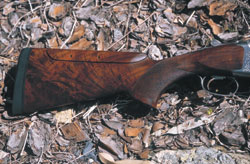 Very highly figured stocks have to be considered carefully with respect to where the grain goes. The weakest section of a gunstock is in the pistol grip area and cross grain in this area can result in a weakness that may lead to failure.
Very highly figured stocks have to be considered carefully with respect to where the grain goes. The weakest section of a gunstock is in the pistol grip area and cross grain in this area can result in a weakness that may lead to failure.
The ideal formula is to have the grain flowing naturally along the form of the stock, with most of the fancy figure in the butt area and relatively straight grain through the pistol grip and fore-end. Very fancy grain in the fore-end area can result in bedding problems if the wood moves around too much with changes in humidity.
Seasoning of the wood is equally important and an excellent blank can be rendered useless by incorrect seasoning. Green wood contains a tremendous amount of water and the rate at which the wood is dried will control the amount of shrinkage.
Companies such as Holland and Holland, who base their business on the ability to supply outstanding stock wood with their outstanding metal work, ensure an on-going supply of quality walnut by buying the wood out of the tree.
A typical stock blank may weight six kilograms green and weigh closer to three kilograms when fully seasoned. The environment in which the wood is stored is important and Australia presents some particular difficulties because of the dramatic variations in humidity that occur here.
Humidity can range from close to 100 per cent in the ‘monsoon’ season on the east coast in February and March and will often go well below 50 per cent in a hot summer westerly. For this reason, oak is a bad choice as gunstock wood, as it is dramatically affected by moisture changes. The Canadian oak used for my kitchen cupboards shrunk by 10mm in 750mm from wet to dry seasons - a totally unacceptable shrinkage level for gunstock applications.
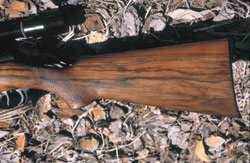 Sealing of the end grain of a blank with paint or wax is essential to prevent uneven drying of the blanks during the two years or more it may take to fully season the wood.
Sealing of the end grain of a blank with paint or wax is essential to prevent uneven drying of the blanks during the two years or more it may take to fully season the wood.
For those not familiar with high-grade walnut, it may come as a surprise that a fancy blank may cost $750 or more and then three-quarters of it will be cut away, again at great expense, to produce the finished gunstock.
Many fine walnut stocks are spoiled by poor finishing. The high gloss polyurethane finishes applied to many modern guns do not do the stock wood any favours and tend to mask the grain rather than enhance it.
Many older guns with oil-finished stocks may darken significantly with age and mask much of the wood’s grain. I do not like linseed oil-based stock finishes for that reason and prefer my own formula, that experience has indicated maintains the full color and contrast of the stock wood indefinitely.
Excessive use of mineral gun oil can also have a negative effect on good stock wood, both by darkening it and also by softening and weakening the wood as it becomes saturated with oil.
Considering it takes 50 to 75 years to grow a walnut tree big enough to cut for timber, it is surprising that supplies of good to excellent quality walnut are still available and many commercial sporting guns, particularly shotguns, turn up with outstanding timber.
I have two Miroku 9000 shotguns that both have exceptionally good wood in the AA-AAA class and looking at them gives me almost as much pleasure as shooting them.
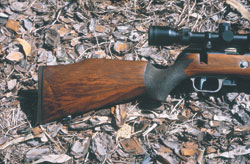 From time to time, above average wood turns up on standard sporting guns, but that is a lucky lottery.
From time to time, above average wood turns up on standard sporting guns, but that is a lucky lottery.
As a lover of good gunstock timber, one of the most alarming experiences I can remember came during a visit to Finland when I was a guest of Sako. We were on a local range going through a hunting licence qualification course. It was quite cold, typical of Finland in autumn, and our host had started a fire, around which we guests were invited to warm ourselves.
Our Sako hosts unloaded a stack of semi-finished rifles stocks from the back of a station wagon and started throwing them on the fire to keep it going. On seeing my alarm, my hosts assured me that all the stocks has small defects and had been rejected at the factory and I watched forlornly as a couple of dozen good-looking bits of walnut that each represented about 75 years of growing into gunstocks went up in smoke.
On reflection, it is even more depressing to consider the number of fine walnut stocks put in the furnace by John Howard in the interests of his gun control agenda. I wonder how many guns with AAA Grade walnut stocks have been used in the commission of a crime in Australia throughout the 20th century.
